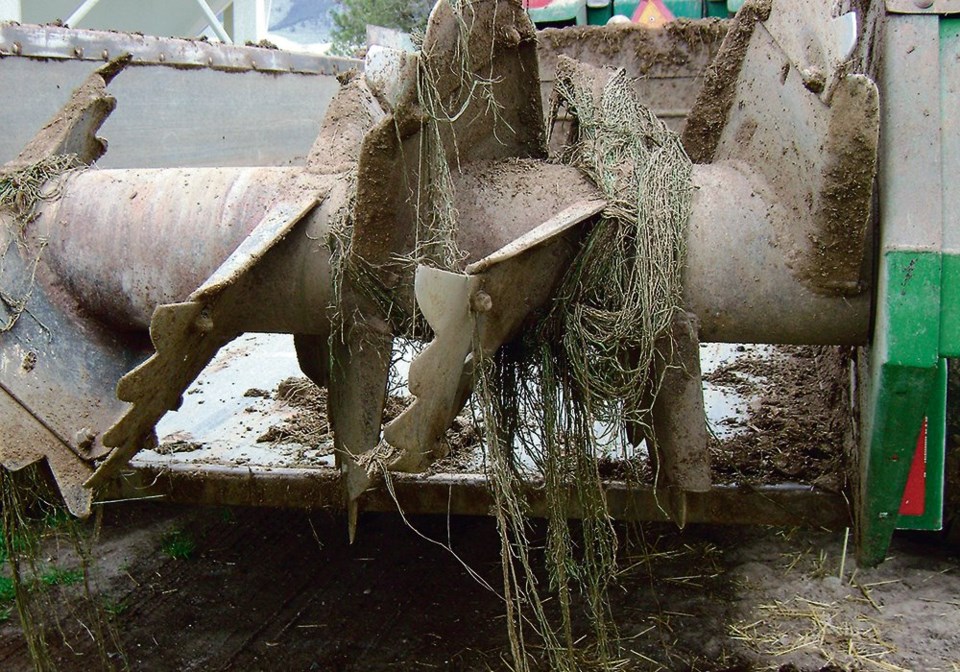WESTERN PRODUCER — Use of net wrap on hay and straw bales carries risks to cattle.
Dr. John Campbell, professor of large animal clinical sciences at the Western College of Veterinary Medicine, says some producers in recent years have lost cows that ingested net wrap left on bales or chopped in a processor.
“This is probably not a common occurrence, but we’ve seen cases of obstruction caused by net wrap,” said Campbell.
“At one time we saw a well-managed cow-calf herd that had approximately six cows that died over a period of two days. The local veterinarian asked me to necropsy two cows that had recently died. Those cows were close to calving and in reasonable body condition.
“The rumens were very large and full of feed. I found large amounts of plastic net wrap occluding the outflow in both rumens. The producer had used a bale processor but did not remove net wrap when processing bales.
“I believe the cows ingested large pieces of net wrap and it was probably not an issue until they became heavily pregnant. Once the fetus got large enough to restrict abdominal space, the rumen became obstructed due to the net wrap. The cows died of what appeared to be suffocation similar to what occurs in bloat.”
Frequency of this problem is unknown, and producers may never realize the cause unless a necropsy reveals net wrap or baling twine inside the animal.
The most common symptoms are poor appetite, weight loss, diarrhea, sometimes a too-full rumen and suffocation. Producers might suspect BVD, hardware, Johne’s disease, salmonella, E. coli, liver flukes, coccidiosis or internal parasites from these same symptoms.
“The herd I investigated had multiple cows that all died within a few days of each other, possibly because they were heavily pregnant,” Campbell said.
“The full rumen caused by the obstruction and large uterus may have put too much pressure on the lungs. In other instances, net wrap may become entangled with all the food material and create blockage at the exit from the rumen into the intestine. This creates a slower demise.”
Chopping material in a processor doesn’t offer protection.
“Perhaps the blades are dull, or the net wrap gets wound around them, or for whatever reason sometimes the processor just shoots the wrap out in one big piece and doesn’t chop it up. In this particular instance, it was obvious that the processor was not chopping up the wrap completely,” says Campbell.
“One of my colleagues thought maybe the cows ate it because they’d run out of feed. Some people wait until cows clean up the previous feed before feeding them again. I’m not sure if that’s a reason, however, because cows will eat all sorts of things even if they have a lot of feed. Once they start chewing on something like baling twine or net wrap, they tend to keep wadding it into the mouth and usually swallow it,” he said.
“One of the cows I opened up had just started to calve. The calf’s legs were entering the birth canal. She may have laid down to calve and couldn’t breathe adequately because of the full rumen,” said Campbell.
Cows who eat bale wrap or twine might also lose weight slowly and show poor appetite. Internal obstruction can prevent adequate solid feed from moving through the digestive system.
“I don’t have any idea how common this problem is, or how often we’re missing it. However, it is probably not a common occurrence and maybe just occurring in the odd cow,” said Campbell.
“If you diagnosed one of these cases while the animal is still alive, you could do a rumenotomy. Open up the rumen and search for foreign material. It wouldn’t be an easy job, with all the food material in there, but something a veterinarian could attempt in order to save the animal.”
However, that would involve extensive surgery.
Plastic material doesn’t break down, so it can potentially stay in the rumen forever, causing later problems, Campbell said.
Large pieces of wrap often lie in the field after the cows have eaten the hay or after bale grazing if the net wrap is not removed first. Not everyone gathers it up later. It can also be difficult to remove wrap at feeding time if it is frozen to the bales.




